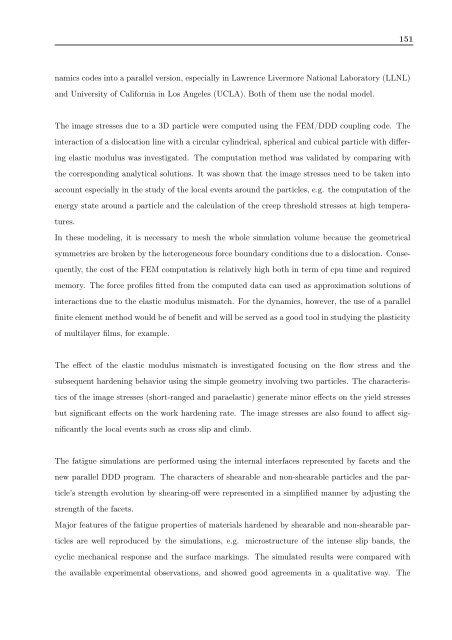3D DISCRETE DISLOCATION DYNAMICS APPLIED TO ... - NUMODIS
3D DISCRETE DISLOCATION DYNAMICS APPLIED TO ... - NUMODIS
3D DISCRETE DISLOCATION DYNAMICS APPLIED TO ... - NUMODIS
Create successful ePaper yourself
Turn your PDF publications into a flip-book with our unique Google optimized e-Paper software.
namics codes into a parallel version, especially in Lawrence Livermore National Laboratory (LLNL)<br />
and University of California in Los Angeles (UCLA). Both of them use the nodal model.<br />
The image stresses due to a <strong>3D</strong> particle were computed using the FEM/DDD coupling code. The<br />
interaction of a dislocation line with a circular cylindrical, spherical and cubical particle with differ-<br />
ing elastic modulus was investigated. The computation method was validated by comparing with<br />
the corresponding analytical solutions. It was shown that the image stresses need to be taken into<br />
account especially in the study of the local events around the particles, e.g. the computation of the<br />
energy state around a particle and the calculation of the creep threshold stresses at high tempera-<br />
tures.<br />
In these modeling, it is necessary to mesh the whole simulation volume because the geometrical<br />
symmetries are broken by the heterogeneous force boundary conditions due to a dislocation. Conse-<br />
quently, the cost of the FEM computation is relatively high both in term of cpu time and required<br />
memory. The force profiles fitted from the computed data can used as approximation solutions of<br />
interactions due to the elastic modulus mismatch. For the dynamics, however, the use of a parallel<br />
finite element method would be of benefit and will be served as a good tool in studying the plasticity<br />
of multilayer films, for example.<br />
The effect of the elastic modulus mismatch is investigated focusing on the flow stress and the<br />
subsequent hardening behavior using the simple geometry involving two particles. The characteris-<br />
tics of the image stresses (short-ranged and paraelastic) generate minor effects on the yield stresses<br />
but significant effects on the work hardening rate. The image stresses are also found to affect sig-<br />
nificantly the local events such as cross slip and climb.<br />
The fatigue simulations are performed using the internal interfaces represented by facets and the<br />
new parallel DDD program. The characters of shearable and non-shearable particles and the par-<br />
ticle’s strength evolution by shearing-off were represented in a simplified manner by adjusting the<br />
strength of the facets.<br />
Major features of the fatigue properties of materials hardened by shearable and non-shearable par-<br />
ticles are well reproduced by the simulations, e.g. microstructure of the intense slip bands, the<br />
cyclic mechanical response and the surface markings. The simulated results were compared with<br />
the available experimental observations, and showed good agreements in a qualitative way. The<br />
151


